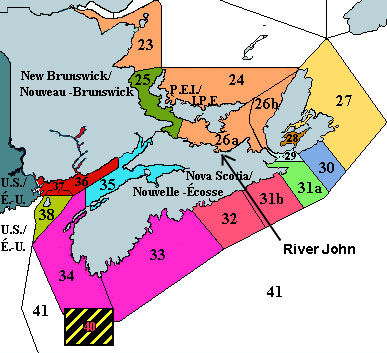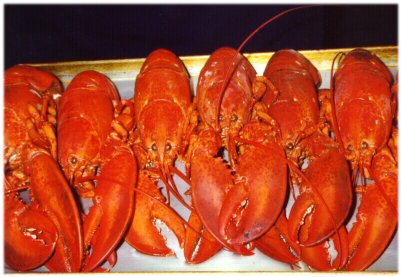|
|
|
|
||||||||||||||||||||||||||
|
Lobster
on Your Plate
The Atlantic lobster is the king of all seafood- or so it is said in the Atlantic region of Canada. Whether it’s picked up at the wharf, bought at the supermarket or delivered to your door, the mouth-watering taste of fresh Atlantic lobster is savored by locals and foreigners alike. The Atlantic lobster is sold far and wide across Japan, Europe, the United States and Canada. The lobster travels from
the depths of the cool Atlantic to restaurants, inns, hotels and resorts
all over the world. It travels to fish markets, supermarkets and
farmers’ markets. It
travels to your church’s annual lobster dinner, to your town’s summer
festival and to the neighbor’s lobster boil at the park. But the most
important place that the lobster travels? Your dining room table where it
anxiously waits to be devoured by YOU! Before you sit down to
devour your meal, read up on how to properly buy, cook, store and eat this
coveted crustacean! Check out
the yummy, local lobster recipes or read up on the nutritional value of
lobster. With the technology we
have today it’s possible to buy lobster at any time of the year no
matter where you are in the world. Because
not all of us are as lucky as those who can buy it fresh from a fisherman,
most of us have to settle for ordering it in a restaurant or buying it in
a store. Another popular way
to buy lobster these days is over the Internet.
Although somewhat pricey, it is a convenient and efficient way to
get lobster to your door. If you decide to shop for
lobster on-line be careful to check the credentials of the company you are
ordering from. If you want to make sure they are legitimate, look for a
phone number to call. Check
various sites and compare prices. Here
are some sites that you can start with: If you are buying lobster
from a supermarket or a lobster pound and can choose them yourself make
sure that they show movement. The
tail should spring back when straightened and the shell should be hard and
thick, indicating the meat to shell ratio is good.
Lobsters must be alive immediately prior to cooking. Estimated yield from
live lobster: A 1 ½ pound lobster yields approximately 1 1/3 cups of meat. A one pound lobster yields 2/3 cup. Reminder: If you’re buying lobster in Nova Scotia it is a lot cheaper to buy it when it is in season. Also, do not go to
wharfs looking to buy lobster right off the boat.
Requests for lobster usually have to be made a few days a head of
time by dealing with the fishermen directly.
You’re best bet for fresh, live lobster is the grocery store or
the lobster pound. (If near Wallace, Nova Scotia stop in and check out their pound located right beside the wharf just on the edge of town.)
Map and information from the
Department of Fisheries and Oceans Website
Boiling lobsters is the
traditional way to cook them. It’s also the most popular and the most
simple. Boil salted water in a large pot (1 tbsp/15ml of salt to 1 quart/1
liter of water). Be sure you have enough water to cover your lobster! Once the
water has boiled, plunge the lobster head first into the water and cover
the pot. When the water
starts to boil again start counting the time.
Cook 7-10 minutes for the first pound (500g) and 2-3 minutes for
each additional pound (500g). Remove
lobster from boiling water and serve warm or cool quickly by running
under cool water. A lobster
is cooked if the antennae and legs separate easily from the body.
If a black oil-like substance is found in the body cavity of a
female this means she was undercooked. (It is the undercooked roe). Lobster may also be
prepared in the microwave. To
prepare it this way place a 1-1 ½ lb (500-700g) live lobster in a 9"
x 13" (3L) oblong baking dish with ¼ cup (50ml) water.
Cover the lobster with plastic wrap and fold one corner back.
Microwave for 9-12 minutes on HIGH until cooked. Other ways to prepare
lobster: steamed, broiled, poached or raw To properly store a live
lobster put it in the refrigerator and cover it with a damp cloth or
newspaper. They will live
this way for up to a day. Do not put lobster in
fresh water or ice. Cooked
lobster may also be kept under refrigeration at 5ºC (40F) for up to two
days. To freeze cooked, shelled
lobster meat, cover with a brine solution-2tsp. (10ml) salt to each 1cup
(250ml) water-leaving a ½ inch (1.2cm) headspace.
Seal tightly and freeze immediately.
To thaw, allow 15-18 hours in the refrigerator, or microwave on
DEFROST for 10-14 minutes per pound (500g). The safest way to thaw
frozen canned lobster meat is to place the unopened can in cold water in
the refrigerator. Allow 2
hours per pound (500g) for thawing. Once
thawed, open immediately. DO NOT THAW in warm water or at room
temperature.
* The entire lobster can
be eaten except the stomach sac that is located behind the eyes* It is a common misconception that lobster meat has little nutritional value. In truth, lobster contains healthy amounts of iron, zinc, calcium and iodine, as well as, Vitamins A, B and B6. It also has no saturated fat and is low in cholesterol and calories. In fact, a 3.5 ounce (100g) serving of boiled lobster meat contains: Protein:
20.5g Cholesterol: 72mg Fat:
0.6g Sodium:
380mg Potassium:
352g Energy:
93 calories | ||||||||||||||||||||||||||||
|
|



